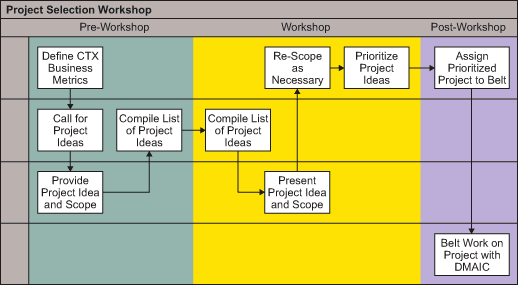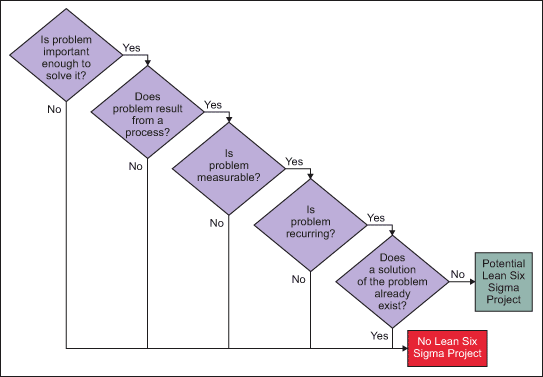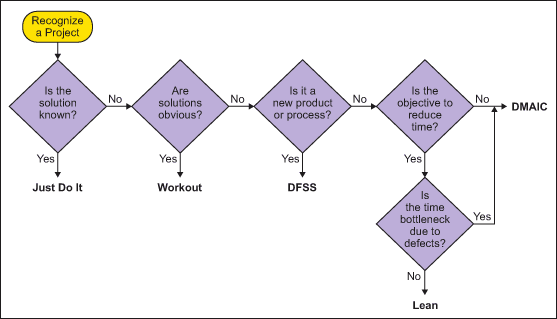
The effective deployment of Lean Six Sigma is done through projects, one by one. While there are a myriad of issues a deployment leader needs to consider – such as training, selection of Belts or even a system for tracking project progress – project definition and scoping remain perennial issues.
An improvement project can be defined through various scenarios. For example, a Belt can simply receive a directive from a Champion or manager to begin a project in a particular process that is screaming for attention. Another approach is for an organization to hold a project selection workshop, which allows practitioners and leaders to identify appropriate project ideas systematically.
One semiconductor company turned to such workshops after trying the first method when it started using Lean Six Sigma both in its manufacturing sites and its sales and marketing areas. Using workshops, teams were able to move forward with projects that fit best with the company’s strategic objectives.
One Company’s Experience
The company, which has 13,000 employees worldwide, manufactures key semiconductor components used in computing and consumer products. With an extensive scope of research and development, manufacturing, logistics, and sales and marketing activities, the company had many opportunities for process improvement.
Projects were initially started with various functional managers proposing their project ideas and putting forth their Belt candidates. It did not take long to realize the downside of this decentralized approach. Project ideas were not necessarily the most critical for the entire organization, even if they were deemed important for certain individual functions. Within a year from deployment, the company embarked on a project selection workshop route to identify and prioritize ideas for execution.
Meeting Objectives
The intent of the project selection workshop is threefold. At the end of the workshop, the desired outcome is:
- A good overview of all collected project ideas from the site
- Well defined and appropriately scoped project ideas that can be translated into an executable project charter
- A prioritized list of project ideas, evaluated using defined project selection criteria
Based on these objectives, the workshop is an event that needs to be managed at the site level. Attempts to hold a project selection workshop in Asia-Pacific involving managers from multiple sites did not go well, with managers from different parts of the value stream attempting to jostle for the relative importance of their project ideas. The managers from different manufacturing sites could understand their project ideas and issues from a common manufacturing view; however, the same could not be said of sales and marketing managers in regard to manufacturing project ideas. Therefore, workshops were organized for all entities from a particular department from one region.
Breaking Down the Workshop: Three Stages
The project selection workshop process can be broadly divided into three stages: pre-workshop, the workshop itself and post-workshop (Figure 1).

Pre-workshop
In order to derive the optimal outcome, there must be adequate preparations and forethought. The Champion, together with the management team, should define the strategic priorities of the organization in the form of critical-to-business metrics. Ideally these should be presented with clearly defined strategic objectives and specific measurable goals. For instance, the Champion from a manufacturing site defined the following plant-level priorities:
- Achieve the module assembly and test cost per 1 gigabit equivalent for different product types as follows: SV = $0.075, PS = $0.050 and CR = $0.030
- Improve the quality defect rate so that SV = 2,400 defects per million opportunities (DPMO), PS = 1,400 DPMO and CR = 1,400 DPMO
- Improve the saleable yield so that SV = 98.5 percent and PS = 99 percent
- Grow the share of consignment in total raw materials stock to more than 50 percent
- Achieve an employee attrition rate of less than 25 percent
The strategic objectives or priorities are then used as a basis to issue a call for project ideas that support the strategic objectives. This call is communicated by the Champion at least one month before the actual workshop, and goes out to the functional managers, Master Black Belt, financial representative and other Belts who will be attending. This can be done in a management meeting or in an email. Regardless of the mode of communication, the Champion should explain the strategic objectives clearly and specify the number of ideas that each department or functional manager is expected to bring to the workshop.
A standard template is used to document the project ideas and their scopes. The ideas collected are compiled with the supporting data enclosed, and the compilation is used as a basis of deliberations during the workshop.
The Workshop
The actual project selection workshop spans from half a day to a full day, depending on the number of project ideas collected. During the workshop each project idea is presented by the proposer and probed by the participants. Supporting data for the project ideas should be presented to facilitate understanding of current and targeted process performance level. This will allow the Champion and Master Black Belt to screen each idea for the appropriateness of applying the Lean Six Sigma methodology.
The project recognition roadmap (Figure 2) and improvement opportunity method selection (Figure 3) are used to screen the project ideas. The valid project ideas are then documented in a project prioritization worksheet.


After all the project ideas have been presented, the valid project ideas in the project prioritization worksheet are scored based on certain predefined criteria (Tables 1 and 2).
| Table 1: Project Selection Criteria (Benefits) | ||||
| Sample Rating | Customer Satisfaction | Financial Impact | Cycle Time Impact | Alignment to Strategic Goals |
| Weight = 9 | Weight = 9 | Weight = 5 | Weight = 5 | |
| 9 | Eases a major customer issue | $1,000,000 | 50 percent decrease | Fully aligned |
| 3 | Reported as a big issue | $300,000 | 25 percent decrease | Somewhat aligned |
| 1 | Somehow related to the customer | $100,000 | 10 percent decrease | Barely aligned |
| 0 | No Impact on customer | No financial benefit | No cycle time influence | No alignment visible |
| Table 2: Project Selection Criteria (Ease of Implementation) | ||||
| Sample Rating | Baseline Data Available | Obvious Pain | Entitlement or Benchmark Available | Internal Complexity |
| Weight = 9 | Weight = 9 | Weight = 3 | Weight = 5 | |
| 9 | Data at hand or in database, immediately available | Re-occurring, constant issue | Immediately available or known | Local or departmental project |
| 3 | Data attainable with some effort | Issue clearly exists | Available with some effort | Few sites or departments involved |
| 1 | Scarce data or high effort required | Somewhat of an issue | Barely exists | Several sites or departments involved |
| 0 | No data available, no source known | Size and breadth of issue is debatable | No data available, no source known | Multiple sites, departments or initiatives involved |
In general, a weighted score is used to rate each valid project idea. On completion of the scoring, a prioritized list of project ideas can be derived based on the weighted scores.
The prioritized project ideas are then reviewed quickly to compare the relative importance of each project idea, and to check whether the priority makes sense.
Post-workshop
As a follow-up to the workshop, the appropriate project ideas are given to the Belts for project initiation. This is done considering the following factors:
- Complexity of the project (Black Belt or Green Belt project)
- Availability of resources to address the project – Is there a suitable Belt who can work on the project?
The Champion and the project sponsor need to define the project charter for the Belt as a mandate for initiating the project. Within the project charter, the following need to be specified clearly:
- Problem statement / business case
- Opportunity statement
- Objective statement
- Project scope
- Estimated project timeline
- Team and resources
Potential Pitfalls
While the project selection workshop process provides a systematic, structured manner to identify and prioritize project ideas, there are numerous pitfalls to avoid:
Lack of Data Orientation
At the semiconductor company there were instances of project proposals made without providing the baseline data. This can give rise to the use of inappropriate assumptions in evaluating a project. For example, a functional manager made a proposal for improving a particular business process, which was later found to have an impact on only one customer. This project idea was prioritized in a workshop and subsequently deployed to a Green Belt. However, on further data collection, the Belt could not continue the project due to its very limited impact.
Lean Six Sigma is a data-oriented approach. Hence, all project ideas presented should be substantiated with data as well as careful analysis of the data. Appropriate trend charts and Pareto analysis should be used to highlight the severity of the issue addressed. At the same time, the targeted process performance should be clearly established with a good understanding of the entitlement process capability, or the best short-term performance of the process. Alternatively, the benchmark performance of a competitor or similar process in another site could be used as a reference point to derive the target.
Lack of Early Financial Representative Involvement
Project benefits should be evaluated with the financial representative early on. In this company, a Green Belt project in its second month of implementation was put on hold by the Champion when it was discovered that the financial savings impact amounted to less than $1,000 per year. This could have been avoided if the project ideas were assessed by the financial representative before they were presented and discussed during the workshop.
Poor Pre-screening
While Champions can be motivated somewhat by the quantity of project ideas brought to the workshop, they also must be mindful of the quality of the ideas. Some project ideas, while valid, might not be best addressed using Lean Six Sigma. These could include projects to install new equipment, start a new operation or implement a new information technology system. The more appropriate approach to run these projects could be a standard project management approach. Hence, the Master Black Belt should play a key role in advising the Champion on the use of the appropriate opportunity improvement method (Figure 3).
Wrong Use of Prioritized Project List
At the end of a workshop for the Sales and Marketing division, instead of assigning the top project ideas to the Black Belts for executing projects, the functional managers involved were more concerned with assigning their project ideas to their own subordinates. Consequently there were limited project ideas that could be assigned to the Black Belts. Champions should put priority on deploying prioritized project ideas to the Black Belts, who are full-time resources in the Lean Six Sigma initiative. Allowing a list of prioritized projects to be used by the functional managers to pursue their own objectives of developing their subordinates should not be cordoned.
Critical Success Factors
Avoiding the pitfalls is not an end in itself. More important, the Champion working with the Master Black Belt or deployment leader needs to identify the critical success factors:
- Active participation by the Champion – Without this, the project selection process can be easily undermined.
- Formulation and communication of the organization’s strategic objectives – Without establishing priorities, practitioners run the risk of defining projects with a limited scope of effectiveness to the organization. In addition, having such strategic objectives but not being able to articulate their importance gives the team only a limited functional perspective.
- Management by fact – Having a culture of speaking by data is important to support the workshop process objectively and systematically. Also, the functional managers and prospective project sponsors should be trained in the understanding and application of Lean Six Sigma. While it is not necessary to train them based on the same curriculum as Black Belts or Green Belts, they should be equipped with clear concepts to define and scope appropriate projects.
Reaching Optimal Outcome
The project selection workshop provides a systematic, structured approach to establish appropriate Lean Six Sigma project ideas to be deployed to Belts. However, there are numerous pitfalls to avoid as well as critical success factors practitioners have to consider in order to ensure that the workshop results in the optimal outcome.